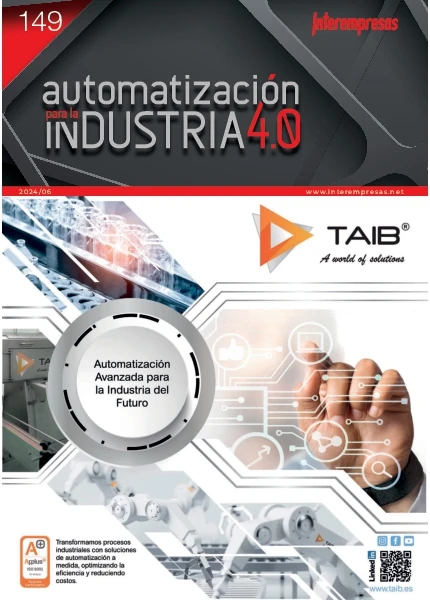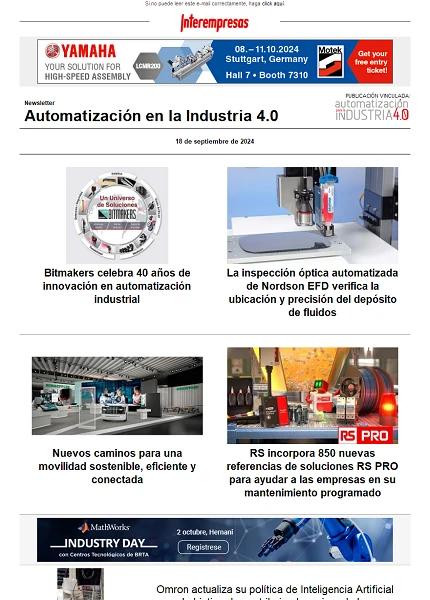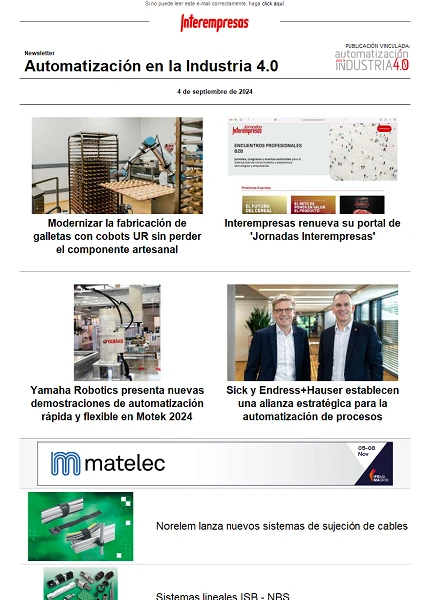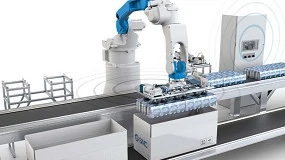The nanotechnology continues his expansion
14 October 2011
During the two last decades has produced an explosion of the activities of investigation and development in the field of the nanotechnology with a considerable investment and effort by part of universities, companies (from small organisations/organizations of recent creation until corporations leaders in all the segments of the industry of the chemical processes) and organisations/organizations of governmental and military investigation of all the world.
In the actuality, many think that the nanotechnology is the key technology of the 21st century. The materials nanoescalados and the technicians of production nanotecnológicas already employ in the production of compound materials that present an improvement of properties like the electroconductividad, the catalytic activity, the hardness, the resistance to the scratches or the autolimpieza, and products of consumption (like the cosmetics and the solar filters) with an aesthetics and efficiency optimised/optimized.
Also are developing applications nanotecnológicas to increase the performance of the sensors of gas and other devices of industrial control, to improve the activity of distinct catalysts, and to produce cells of fuel improved and batteries lighter and durable. In the field of the medicine, is investigating an imaginative group of particles nanoescaladas that will allow to increase the efficiency of powerful medicines against the cancer in the human body. Said particles can do that these agents accumulate preferably inside the tumors and other cells cancerígenas, salvaguardando like this the surrounding healthy fabric and minimising/minimizing the devastadores collateral effects that often comport the chemotherapy and the treatments against the cancer that employ radiations.
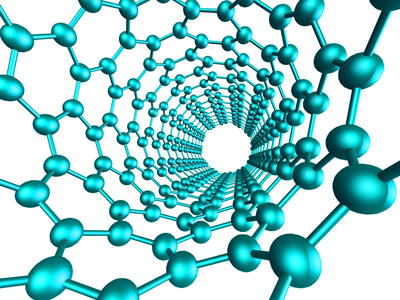
The improvement in the properties of the materials increases the performance
Given the reverse relation that exists between the size of the particle and the surface, the diminutas nanopartículas have of an extraordinarily wide surface, doing that many material (included the metals, the metallic oxides, several forms of silicon, clays and new compounds of the carbon) improve numerous properties and characteristic physics regarding his formulation in macroscopic particles.
Nanotubos Of carbon
A type of structure to scale nanométrica concrete that is arousing quite interest is the nanotubo of carbon. Applied for the first time at the beginning of the ninety by the researchers of chemical engineering of the University Crimp, Houston, the nanotubos of carbon are in the actuality object of study in innumerable universities and companies: Hyperion Catalysis International, Carbon Nanotechnologies, Showa Denko K.K., Mitsui & Co., the National Institute of Science and Industrial Technology Advanced of Japan, the Institute of Technology of Tokyo and a long etcetera. These organisations/organizations are working in the development and improvement of forms commercially viable to produce nanotubos of carbon, and of new applications that take advantage of his structural properties, mechanical and only electronics. Nevertheless, it is a German company the one who probably will produce for the first time nanotubos of carbon (CNT) with commercial ends on a large scale: Bayer MaterialScience and Bayer Technology Services have attained a production of CNT more profitable. Now they find in process of escalamiento of this procedure (see
The nanotubos of carbon are perfect cylinders, composed by atoms of carbon hexagonalmente willing, closed in both extremes by cofias hemispherical whose diameter measures some tens of nanómetros. Can produce nanotubos monopared (SWNT) or multipared (MWNT). In general, the nanotubos of carbon have of a surface of until 1.500 m2/g and of a density of 1,33-1,40 g/cm3. In function of his structure can work like drivers or semiconductors of the electricity and the heat. They present a thermal stability and chemistry extraordinarily high, are extremely elastic (with a module of elasticity of roughly 1.000 GPa) and can bear an elongación of the 10-30% before breaking .
But perhaps his more valuable characteristic is his strength tensil, that can surpass the 65 GPa (with a planned value of until 200 GPa). To illustrate his capacity, is used to say that the nanotubos of carbon has a strength tensil 100 upper times to the one of the steel with so only a sixth part of his weight. This stood out group of material properties opens the door to a sinfín of industrial applications.
The researchers also are studying new forms of obtaining, and developing and escalando the already tested processes so that the production of the nanotubos of carbon was profitable (and can carry out in mass). The key roots in attaining produce nanotubos with constant and predictable dimensions, levels of acceptable purity and structural defects minima (since these can modify radically the planned behaviour/behavior of the particles nanoescaladas).
In the actuality, the nanotubos of carbon are integrating in distinct matrices, included the fluoropolímeros, like the etileno-tetrafluoroetileno (ETFE) and the fluoride of polivinilideno (PVDF). In this way it looks for produce compound ultraligeros with an exceptional strength and other functional advantages regarding the conventional materials, that allow to create advanced membranes of thin film, fibres/fibers, foams and revestimientos. These innovative composed already are using in numerous applications of the sector of the car, the electronics and the manipulation of materials: specifically in those that require a precise control of the static electricity, an improvement of the chemical resistance, a barrier for the permeación chemical upper, properties of lubricación inherent and a greater resistance in front of the slide regarding the conventional materials that are not reinforced with nanotubos. Besides they are studying like key components in the advanced sensors, electronic and optical devices, catalysts, batteries and cells of fuel of the future. In this last case, for example, has showed that the use of nanotubos of carbon improves the performance of the cells of industrial fuel and at the same time reduces to a large extent the quantity of catalyst of necessary platinum.
The researchers of the NASA also are developing nanocompuestos of poliimida that incorporate SWNT to improve the resistance to the radiation and the break, and the thermal and electrical conductivity, characteristic these important for the construction of aeroplanes and space ships.
Commercial applications of the nanotechnology
Composed polymeric
In addition to the nanotubos of carbon, the nanopartículas of other a lot of materials are using like functional additives in the production of several compounds advanced. The mix of small quantities of these diminutas particles in several polymeric resins gives place to innovative compounds that present important improvements in his material characteristics: electrical conductivity, catalytic activity, hardness and the resistance to the scratches, fireproof properties, characteristics of barrier of diffusion, and even functions of autolimpieza (or ease to clean) and antimicrobic properties. Dupont, BASF, Degussa, Toyobo and others find to the avant-garde in this field.
The use of particles nanoescaladas like functional additives allows to use loads much lower that with the conventional additives. For example, a nanocompuesto usually contains a 3-5% of his weight in nanoarcilla or other nanopartículas, whereas the compounds reinforced conventional are used to to require the addition of a 20-40% of his weight in filling micrométrico, like the talc, the mica, the carbonate of calcium, the amianto, the graphite and several oxides. These indexes of load relatively heights has some disadvantages, like the reduction of the clarity of the polymer (the inclusions micrométricas do that it lose transparency because they disperse the light), the increase of the fragility and a greater density. Instead, these effects do not produce when they use proportions of particles nanoescaladas relatively diminutas.
Ceramic advanced
The ceramics of high traditional performance produce with dusts whose constituents possess an inferior diameter to a micrometer or 1.000 nanómetros. However, although the ceramic products finishings are used to to be resistant to the high temperatures and the corrosion, are fragile and difficult to work. The production of ceramics with dusts composed by particles a lot lower (of 100 nanómetros of diameter or less) has showed remarkable improvements.
For example, the dusts nanoescalados of zirconium (ZrO2) and aluminium/aluminum (To the2Or3) use like component of structural ceramics with a greater hardness and resistance to the fracture and the astillado. The use of these ceramics optimised/optimized is increasingly frequent in industrial teams that usually experience high temperatures, conditions of hard operation and an excessive wear, as for example the components of the bombs, the tools of court and extruders, the cojinetes and together, the filters and membranes of high temperature, the refractory materials, the catalysts, the sensors advanced, the electronic components, and the components of the engine of the cars.
The use of ceramic dusts nanoescalados presents an additional advantage. Since it exists a strong relation between the temperature of sintering and the size of the particle, has showed that the possibility to reduce the size of the particle of the initial material to roughly 20 nanómetros reduces the temperature of sintering of the zirconium of 1.400 °C to 1.110 °C.
Degussa Has improved the security of the batteries of ion of lithium thanks to Separion. When the batteries of ion of conventional lithium break , can ignite. Instead, Separion reduces to a large extent this possibility, since of the battery only can go out a very small cloud, quite inofensiva, avoiding that it generate a heat extensivo. Besides, Degussa has developed a revestimiento ceramic for the walls in his centre/center Nanotronics that will go out to the market shortly.
Products of consumption
The manufacturers of solar filters, cosmetics and other products of personal care have discovered that the use of versions to scale nanométrica of common additives can improve the effectiveness and appearance of a lot of products in comparison with the conventional formulas. For example, they exist new affordable methods to produce and use particles nanoescaladas of the substances that commonly use to block the ultraviolet rays, the oxide of titanium (TiO2) and the oxide of cinc (ZnO), that allow to the manufacturers of solar filters employ these agents of blockade of wide spectrum in the preparation of transparent lotions, aesthetically upper to the creams of white and opaque oxide that they are the signal of identity of surferos and lifeguards. Of the same way, the nanopartículas of TiO2 use to add characteristics of blockade of the ultraviolet rays to glaze them, textile fibres/fibers and films of the containers. Merck Produces nanopartículas that improve the appearance of the skin creased. These reflect the light, and when they apply to one creases, light his interior. In this way it gives the feeling that it creases is not so deep as before (or even that it has disappeared).
Products of polishing for semiconductors
One of the uses of the nanopartículas more consolidated is the one who does during the planarización mechanical chemical (CMP): a process of polishing extremely require that it uses during the production of integrated circuits in chips semiconductors. During the CMP, the particles nanoescaladas of abrasive materials (usually oxides of aluminium/aluminum and zirconium, silicious coloidal or pirógeno, and cerium with diameters of 20-300 nm) formulate in an agent of polishing that uses to straighten and perfect the metallic and dielectric layers of the integrated circuits of silicon. The surfaces of polishing for optical applications with nanopartículas is one of the fields of investigation of German Competence Center for Ultra Require Surfaces, in Brunswick (www.upob.de).
Sensors of gas and other analytical devices
The scientific community also works with ahínco in the aprovechamiento of the extraordinary surface and increase of the catalytic properties and reactivity of many material nanoescalados to develop sensors of gas highly sensitive and other analytical devices (for example, those that use to check the quality of the foods, improve the detection of illnesses, and control possible chemical risks, biological, radiológicos and nuclear).
The sensors of gas of oxide of metal resistivo (that they use, for example, oxides of cinc, tin, titanium and iron) base his operation in a change in the electrical conductivity in the surface of the sensor when east goes in in contact with the objective gas. The use of particles nanoescaladas of key materials can increase to a large extent the sensitivity to detect the gas, the selectivity and the time of answer, since it increases considerably the reactive surface in the tip of the probe.
In the field of the chromatography of gases are attaining similar advances. For example, up to now the modules of chromatography of gases (GC) miniaturizados for the analysers of gas had limited to applications that involved the measurement of organic compounds. Recently, SLS Microtechnology GmbH and the researchers of the Technical University of Hamburg-Harburgo have developed columns of GC in miniature (of the size of a charge card) that are endowed of nanotubos of carbon monopared in an integrated circuit of silicon. According to the researchers, the new system makes possible the decomposition of inorganic gases like the CO2, NOx and Or2.
Catalytic applications and fotocatalíticas
The development of catalysts of high efficiency also takes advantage of the enormous surface that offer the particles nanoescaladas. For example, the nanopartículas of gold use to improve the processes of oxidation to low temperature, included the oxidation of the monoxide of carbon in a current of hydrogen, the selective oxidation of the propene in propileno, and the oxidation of chemicals that contain nitrogen.
Of the same way, when they expose to the ultraviolet light (UV), the substances fotocatalíticas, like the form anatasa of the dioxide of titanium (TiO2), absorb to a large extent the radiation UV. In presence of the water, the oxygen and the light UV, these substances generate free radicals that decompose the no wished chemicals and reduce the adhesive strengths that join the dirt and the seaweeds to distinct surfaces. This effect fotocatalítico Is taking advantage of in several commercial applications, like the purification of the water and the air, or to endow distinct surfaces of properties autolimpiables, antimicrobic and antialgas. For example, it has applied to decompose the soot in the walls of the tunnels of the autovías in Japan.
Mechanisms for the administration of medicines and treatments
Nowadays, the advances in nanotechnology applied to the medicine and the health can revolutionise/revolutionize this field. In the actuality, is looking for a big variety of nanomaterials biocompatibles that allow to develop fabrics and artificial organs, and prosthesis of hip and of knee improved. For example, the researchers of GfE Medizintechnik GmbH, Núremberg, Germany, have developed a process of revestimiento based in the nanotechnology that improves the biocompatibilidad of the materials of the implants to base of conventional polymers (that they tend to the inflammations or rejections) adding a layer of titanium of so alone 30-50 nm of thickness.
In this same line, the researchers of the University Purdue have discovered a form of revestir the artificial articulations of titanium with a dense layer of nanotubos formed by rings of acid desoxirribonucleico (DNA) autoensamblados, that does that the medical implants, like the prostheses of hip, are less irritantes for the human body. These nanotubos are composed of guanine and cytosine, two of the basic molecules of the genes.
On the other hand, one of the advances nanotecnológicos more promising of the medical surroundings is the use of materials and devices nanoescalados to improve the diagnostic of the cancer and create new forms to direct the administration of the powerful, and often toxic, medicines quimioterapéuticos, reducing like this his effects of limitation of the dose.
In oncología knows that, when they detect of early form, a lot of types of cancer can treat , and a prompt intervention offers better results. In consequence, the design of strategies more effective in the detection of the cancer (to scale molecular, before they form tumors in a stadium advanced) also is a field of interest for the researchers of the nanomedicina in the actuality.
Medical diagnostic
During the two last decades, the evolution of the nanocristales fluorescent semiconductors, known like quantum points, has marked the beginning of a new was in the medical diagnostic and in the laboratory. These nanocristales usually are composed by seleniuro of cadmium, sulphide of cadmium or telururo of cadmium, and have a revestimiento of inert polymer. Said revestimiento salvaguarda the human cells of the potential toxicity of the cadmium, and at the same time allows to the developers of the medicines join distinct molecules that facilitate the preferential assimilation of quantum points (and other nanopartículas) by part of the objective cells.
When modifying the diameter of the quantum points, these can absorb and issue light with distinct wavelengths, being able to like this encode by means of colours/colors. In consequence, the quantum points can use to encode with colours/colors and follow distinct cellular processes, different types of cancer or distinct phases of the same cancer. For example, the researchers of the UCLA and the University Stanford labelled the quantum points with an isotope that issues positrones and injected them in mice. Afterwards, by means of the scanner of tomography by broadcast of positrones (TEP), the researchers could observe how the points cánticos advanced by the vascular system until the liver over time. The Professor Weiler, of the University of Hamburg, Germany, has sintetizado nanopartículas and is testing a wide range of applications.
On the other hand, the researchers of the University of Texas, in Austin, and the MD Anderson Cancer Center of Houston have developed a soluble formula in water that contains fluorescent quantum points labelled with an antibody monoclonal that adheres to the receptor of the factor of growth epidérmico (RFCE). This, as it believes , is a precocious predictive marker of the cancer of neck of útero. Thanks to these quantum points labelled, that light when they receive the light, the researchers of Texas could distinguish the cultured cells that produced an excess of RFCE of those that did not do it.
The researchers of the University of Vanderbilt have discovered a form to modify quantum points joining small pieces of the polietilén glycol (PEG) biocompatible to reduce considerably the no specific links with several types of cells. Between the companies that participate in the production and the use of the quantum points include Evident Technologies and Invitrogen Corp. (That recently it has purchased Quantum Dot Corp. And the unit of business BioPixels of BioCrystal, Ltd.).
When they treated to increase the efficiency of the magnetic resonance imaging (MRI), the researchers of the University Yonsei, in Seoul, South Korea, discovered that injecting a formula of nanocristales magnetic labelled with a concrete antibody (one that fixes firmly in the cells of the cancer of breast) in mice, this traveled/travelled quickly until the location of the tumors, allowing detect the cells cancerígenas by means of a scanner MRI an hour after the injection. Alnis Biosciences Also has developed a formula of nanopartículas magnetic to improve the detection of tumors by means of MRI.
The researchers of the University Purdue are using diminutos “nanobastones” of gold, that are almost 200 smaller times that a red globule, to create a technician of medical image ultrasensible for the cells. When injecting the claves in the bloodstream of the mice, and light them with laser through the skin, these researchers were able to produce images almost 60 more brilliant times that those that obtain with the conventional fluorescent dyes.
On the other hand, the scientists of the University Crimp have inserted gadolinium in nanotubos of carbon to produce agents of contrast improved for the IMR of high resolution. Schering Is commercialising/commercializing his agent of contrast Gadomer, that contains gadolinium complejado with dendrímeros (nanopartículas organic with form of tree created out of nowhere).
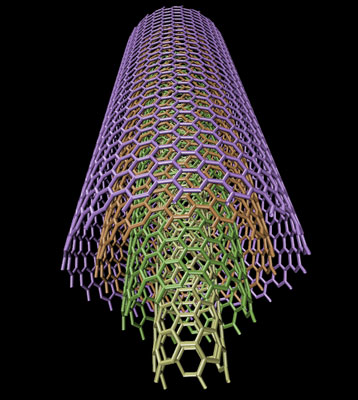
Administration of medicines directed
The pioneers in nanotechnology work in the actuality for sintetizar and deploy a varied range of structures nanoescaladas whose aim is to improve the form of administration of therapeutic agents of high efficiency. These include nanopartículas polymeric and dendrímeros biodegradable and biocompatibles, as well as nanocápsulas of silicious-gold, that can happen diminutas loads of medicines against the cancer or agents of image to the cells cancerígenas. The Professor Kreuter, of the University of Frankfurt/Main, has developed a medicamente nanoencapsulado for the treatment of the glioblastomas, a type of cerebral cancer. The glioblastomas can not delete by means of surgery because they form a species of cloth of spider in the brain. Therefore, in the actuality the glioblastomas are 100% lethal. Since the pharmaceutical products for the normal cancer can not cross the barrier hematoencefálica, the treatment with these conventional medicines does not work. Instead, if it enters the medicine in a capsule of “food for the brain”, the organism thinks that only is transporting nutrient to the brain when it also carries the therapeutic agent.
In the majority of the applications of administration of medicines to nanoescala, the encapsulado of the treatment against the cancer or the agent of image so only allows to win the half of the battle. To achieve that the diminutas particles accumulate preferably in the objective cells, the researchers are trying to link distinct ligandos selective, like the peptides, the proteins or the antibodies, to the surface of the nanopartículas.
Also are carrying out studies to design mechanisms of effective activation that allow to these diminutos horses of Troy, once accumulated in the cells cancerígenas, free his load in function of the needs, well of an alone time or of gradual form.
According to his manufacturer, the patients treated with Abraxane assimilate of safe form 50% more than paclitaxel by dose that those that only take this medicine. Besides, a clinical essay carried out between 454 patients with cancer of breast metastásico showed that those that took Abraxane attained an index of answer in front of the tumor of almost the double that those that only took paclitaxel.
Unlike the Abraxane, that employs nanopartículas to base of albumins, the researchers of the University of Rutgers, Insert Therapeutics, the National University of Singapore, the University of Cardiff in Wales, the Medical Centre/Center of the University of Nebraska, Alnis Biosciences, Access Pharmaceuticals, pSivida, MIV Therapeutics Limited, Elan Corp. And EntreMed, amongst other, are developing nanopartículas to base of polymers biocompatibles to improve the administration of powerful medicines against the cancer.
Another type of innovative structure nanoescalada appeared during the last decade is the one of the dendrímeros arborescentes, whose use for the intracellular administration of medicines also is being object of an active investigation. Sintetizados From monomers, the dendrímeros possess a configuration arborescente three-dimensional of approximate size of a half protein, and his multiple branches offer an extraordinary surface that makes possible the adhesion of medicines for the tumors, agents of image and selective molecules.
Starpharma Holdings Ltd. It has developed VivaGel: purportedly the first application to base of dendrímeros that has presented to the Administration of Foods and Medicamente (FDA) American for his normative permission. VivaGel Is a microbicida topical vaginal designed to warn the transmission of the HIV, the genital herpes and other illnesses of sexual transmission. In the actuality have initiated the clinical essays of the Phase II of the product.
Does some years, the FDA put VivaGel in the “fast road”, a designation that allows to surpass the process of normative permission with greater rapidity to the products that treat grave conditions or that suppose a threat for the life.
The researchers of Dendritic NanoTechnologies (DNT), the University of Michigan and Avidimer Therapeutics also are developing treatments against the cancer based in dendrímeros.
How achieve that the nanoportadores free his load
In the actuality is studying an imaginative group of mechanisms of activation that provide greater control on the moment and the form in that a vehicle nanoescalado frees his load of medicine inside a cell. The researchers of the University Northwestern, of the Institute of Technology of Massachusetts (MIT) and of the University of Tokyo, for example, have developed nanopartículas sensitive to the pH that dissolve when they go in in contact with the sour pH of the interior of the cells cancerígenas.
The researchers of the University of Melbourne are using revestimientos of gold to help to his nanopartículas of polymers to free his load of enzymes or medicine in function of the needs. By means of an impulse of light laser of a nanosegundo (that the nanopartículas of gold absorb quickly), the researchers could break his walls and free the content.
On the other hand, the researchers of the Faculty of Medicine of the University of Washington have showed that, when they subject to ultrasound during five minutes, the cells of melanoma cultivated assimilate ten times more nanopartículas of perfluorocarbono liquid that when it does not apply ultrasound. The researchers think that the exhibition to the ultrasound improves the exchange of molecules between the nanopartículas soluble in the fat and the lipids (molecules fats) that conform the cellular membranes.
Thermal ablation
Although the new platforms of administration of medicines result very promising, another method for the treatment of the cancer based in the nanotechnology that is strengthening between the researchers is the treatment no invasivo of the cells cancerígenas (no by means of medicines, but with heat) to destroy the malignant cells from his interior. Although each one of the approaches varies, all base in a same concept: in the first place, it enters some type of nanopartícula magnetic in the cells cancerígenas or tumors, and afterwards, applies a source of external energy (that is to say, activation through light laser or exhibition to an oscillating magnetic field) to generate a heat that destroys the ill cells. The researchers are evaluating the use of nanotubos of carbon, nanopartículas of oxide of magnetic iron, nanocápsulas and nanoceldas of gold that act like “escalpelos thermal”.
The scientific institutions and companies that study these applications include, between others, the University Crimp, Nanospectra Biosciences, the MD Anderson Cancer Center, Oak Ridge National Laboratory, the University of California - San Francisco (UCSF), the Institute of Technology of Georgia, the University of Paris, Triton Biosystems, MagForce Nanotechnologies GmbH, the University of Stanford, the University of Delaware and the Kimmel Cancer Center of the University Thomas Jefferson.
Regarding the cancer, the nanotechnology would not have to consider the panacea, since only the time will say if the promising current advances in this field will happen successfully the proofs of concept to arrive to the clinical essays in human beings on a large scale and finally turn into practical clinical and therapies authorised/authorized and commercially available. Nevertheless, the inventive application of concepts, material and systems nanotecnológicos constitutes a blow of cool air that is carrying a lot of hope to the field of the diagnostic and the treatment oncológico.
Forms of production
In the actuality already exist or are developing varios methods to produce nanopartículas of distinct materials. In general, are six the most used methods for the production of partículas nanoescaladas (of roughly 1-100 nanómetros of ro) Of distinct materials:
- The methods of the arch of plasma and the hydrolysis of flame (included the ionisation/ionization of flame) suponen the use of plasma to high temperature or of a reactor of ionización of flame (both involve methods of gas to particle and of gotita to flame)
- The chemical deposition of steam (CVD), in which rial Of game vaporises/vaporizes and afterwards condenses on a superficie, usually in empty
- The technicians of Deposition, by which isolate species with a precise control from a solution until forming a film of surface nanoescalada
- The synthesis sun-gel, a humid method-chemical that permite sintetizar material nanoescalados of high purity and homogeneidad to low temperatures and in conditions softer that with métodos of high similar temperature (the inorganic method or “coloidal“employs metallic salts in an aqueous solution, like the , oxicloruro or nitrate, like prime matters; the method metal-organic or”alcóxido” employs alcóxidos of metal in dissolvent orgánicos)
- l aplastamiento mechanical by means of mill of balls, que powders materials of conventional game (like the oxides metálicos) through mills of balls of high conventional energy
- The use of nanomaterials that produce of natural form; some materiales that produce of natural form, like the ceolitas, pueden sintetizar and modify by means of the conventional chemistry for generar particles of dimensions nanoescaladas
In addition to the técnicas showed that they have mentioned previously, exist other métodos promising to produce particles nanoescaladas of several metales. These include:
- The reactors of flame or flame of That enter an additional flame behind the zone of reaction to transform the aggregated in spherical particles of form more
- Processes of plasma improved, designed to favour/favor a faster refrigeration and produce less agglomerated
- The methods of processing sonoquímicos, in which a process of Acoustic ion generates a hot zone located transitory with %even gradient of temperature and pressure extremely high
- The procesos of cavitación hydrodynamic, in which they generate nanopartículas by means of the creation and broadcast of bubbles of gas inside e una solution sun-gel
- The technicians of microemulsión, that prometen sintetizar silicious metallic semiconductor, sulphate of barium, nanopartículas magnetic and superconducting
- Technologies of perlado
- Chemical molecular
The most critical sectors with the nanotechnology urge to the caution
The nanomaterials present properties modified like consequence of the increase of the relation surface/volume, a greater superficial energy and a size of the particle reduced. The alteration of these characteristic could give place to distinct properties toxicológicas and ecotoxicológicas of the inner mass of the material. These possible changes in the properties of the substance arouse in the actuality a debate on an international scale on the idoneidad of the technologies and methodologies of measurement of the exhibition and strategies of essay toxicológico existent to value the possible dangers, and in consequence analyse/analyze the potential risks of the nanomaterials. The nanomaterials have to be safe for the human being and the environment. To guarantee a responsible use of these, is precise that the institutions of public investigation and deprived of all the world continue with the intense study on his security that are carrying out in the actuality.


